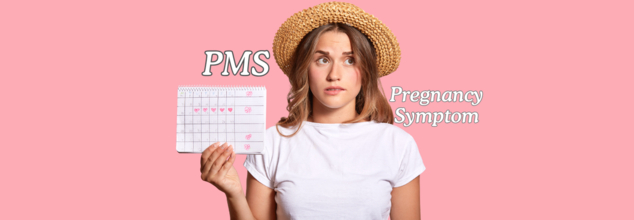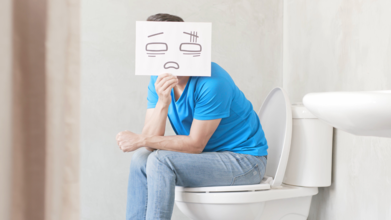- Health Conditions A-Z
- Health & Wellness
- Nutrition
- Fitness
- Health News
- Ayurveda
- Videos
- Medicine A-Z
- Parenting
- Web Stories
8 Signs Of 'Pregnancy' That Are Likely PMS

Image Credit: Health and me
Most women who are not ready for a pregnancy at a particular moment, always find themselves spiralling at the thought of experiencing even the slightest symptom that could resemble one—sore breasts, nausea, or fatigue. Defenses go up, and women end up overanalyze every ache and shift, fearing the unexpected, despite knowing it could just be PMS.
Hormonal fluctuations play a critical role in the way our bodies function, influencing everything from mood to metabolism. For many women, the days leading up to their menstrual period come with a host of physical and emotional symptoms collectively known as premenstrual syndrome (PMS). However, these very same symptoms can also indicate early pregnancy, leading to confusion and uncertainty. If you’ve ever wondered whether your bloating, mood swings, or breast tenderness signal the arrival of your period or a potential pregnancy, you’re not alone.
While a missed period is often the most definitive early sign of pregnancy, there are several overlapping symptoms that can make it difficult to distinguish between PMS and early pregnancy. Below, we take a closer look at eight symptoms that may seem like PMS but could also be indicative of pregnancy.
1. Breast Tenderness and Swelling
Both PMS and early pregnancy may cause breast tenderness due to increased levels of estrogen and progesterone. However, during pregnancy, breast pain may feel more pronounced and persistent, outlasting the anticipated onset of menstruation. Also, the areolas may darken, a phenomenon that is not seen in PMS.
2. Fatigue and Low Energy
Feeling too tired? Tiredness is one of the most common PMS symptoms, but it can also be an early and one of the most common signs of pregnancy. The body increases its production of progesterone in early pregnancy, which can lead to persistent tiredness. While PMS causes a person to feel tired, the tiredness associated with pregnancy is more extreme and does not subside with time.
3. Mood Swings and Emotional Sensitivity
PMS has long been notorious for mood swings, irritability, and an increase in sensitiveness. Equally, in pregnancy, a lot of hormone surges result in mood swing. However, mood swings experienced during pregnancy often last longer and are more pronounced and are characteristically accompanied by feelings of strong emotions or anxiety.
Also Read: Do Men Experience Pregnancy Symptoms Too? Know About The Couvade Syndrome
4. Abdominal Cramping
Mild cramping is one of the common symptoms of PMS, but it may also happen during early pregnancy as caused by implantation. Implantation cramping is caused when a fertilized egg attaches to the uterine lining. This happens between 6-12 days after ovulation. Unlike menstrual cramps, which become more severe as the period gets close, implantation cramps are usually minimal and temporary.
5. Bloating and Digestive Discomfort
Classic symptoms of PMS are bloating caused by fluctuations in hormones which make the individual retain water, while early pregnancy is also due to increased progesterone causing delayed digestion that produces gas accumulation. Pregnancy-induced bloating could, however persist for a more extended period compared to PMS where it could fade away at the onset of menstruation.
6. Alterations in Food Intake and Cravings
Both PMS and early pregnancy can cause cravings or aversions to odd foods. However, the urges often are much stronger and more selective when pregnant, and the aversion may escalate into nausea and even morning sickness. Another symptom unique to pregnancy, which is rarely experienced with PMS, is increased sensitivity to odors.
7. Urine Pressure
An increased urge to urinate is not a common symptom of PMS, but it is one of the earliest signs of pregnancy. This happens because, after implantation, the body begins producing human chorionic gonadotropin (hCG), a hormone that increases blood flow to the kidneys, thus making a person go to the bathroom more often. If you experience a sudden and unexplained increase in urination without other symptoms of a urinary tract infection, pregnancy might be a possibility.
8. Light Spotting or Implantation Bleeding
Perhaps the most distinguishable feature of early pregnancy is that of implantation bleeding. This is the process of the fertilized egg attaching to the uterine lining. This sometimes results in light pink or brown spotting that's mistaken for a period. Unlike menstrual bleeding, which can be quite heavy and lasts for several days, an implantation bleed is usually very light and temporary.
If in Doubt, When Should You Take A Pregnancy Test?
If you are experiencing these symptoms and suspect pregnancy, the best way to confirm is by taking a pregnancy test. The "two-week wait" refers to the period between ovulation and when enough hCG has built up in your system to register on a test. Home pregnancy tests are highly accurate when taken after a missed period, though testing too early may lead to false negatives.
When to Consult a Doctor?
If you have symptoms that last longer than your typical PMS cycle or are different from what you have experienced before, such as intense cramping, prolonged spotting, or extreme fatigue, you should see a doctor. A blood test is much more sensitive to pregnancy than a home test, and a doctor can help eliminate other causes for your symptoms.
While there is significant overlap between PMS and early pregnancy symptoms, subtle differences can help distinguish between the two. Understanding your body's patterns and tracking your symptoms can provide clarity, but when in doubt, a pregnancy test or consultation with a medical professional remains the most reliable method for determining whether you are pregnant.
Harvard Psychologist Lists Careers Linked To Higher Rates Of Suicide: Doctors Maybe At High Risk Themselves

(Credit- Canva)
Suicides are one of the leading causes of death around the world. While it is easy to say that the person who chose to take their lives did it of their own violation, Harvard psychologist Dr. Matthew Nock, explains the other side. “90% of people who try and kill themselves say, I didn't want to die per se. I wanted to escape from seemingly intolerable.” Speaking on the On Purpose podcast with Jay Shetty, Dr. Nock pointed out that the link between work pressure and suicidal thoughts varies by race and ethnicity.
The concerning rise in suicide cases tied to work pressure has fueled a social media conversation about toxic work culture. What was once considered a normal part of the professional grind is now being openly challenged, as people share personal stories of the anxiety, depression, and isolation caused by unhealthy work environments.
What Professions Are At High Risk Of Suicide?
According to Dr. Matthew Nock, certain careers are linked to a higher risk of suicide.
Police Officers
He noted that physicians and police officers are among those at high risk. He mentioned a spike in suicides among New York City police officers, who are predominantly white men, and shared that female police officers, in particular, face a higher risk, even when accounting for factors like age, race, and ethnicity.
According to a 2025 study published in the Police Practice and Research, on average, 21.4 out of every 100,000 officers died by suicide each year.
The study showed that the suicide rate was much higher for male officers (22.7 per 100,000) than for female officers (12.7 per 100,000).
Physicians
Dr. Nock explained that access to means is a significant factor in these high-risk professions, which helps explain why physicians, police officers, and military members have a much higher risk of suicide compared to others.
Another study published in 2024 The BMJ, showed that the number of suicides among doctors has been going down, female doctors are still at a much higher risk than other people.
When looking at all the data, male doctors were found to have a 5% higher risk of suicide compared to the general population.
In a more recent analysis of the last few years, the overall suicide rate for doctors has decreased, which is good news. But even with this improvement, female doctors still have a 24% higher risk than the general public.
Why We Need To Talk More About Suicide
Dr. Nock stresses the importance of openly discussing suicide, particularly in schools. He compared it to fire drills or earthquake preparedness, saying that since 15% of people will experience suicidal thoughts, it's crucial to equip everyone with a safety plan..Dr. Matthew Nock said, "We know that asking about suicide, talking about suicide, does not make people suicidal."
He noted that the people who act on suicidal thoughts often show different signs than those who just have the thoughts. While depression is a strong predictor of having suicidal thoughts, other factors like anxiety, aggressiveness, poor behavioral control, and drug or alcohol use are more closely linked to a person actually attempting suicide.
He believes that a small educational module on suicide in health class could help save lives by teaching people what to do if they or someone they know is struggling.
Lung Cancer Rates Linked With Pollution Are Down In US, But THIS Country Is Still Suffering: Study

(Credit- Canva)
While we all know air pollution affects our health, did you know that it was actually driving cancer cases higher? This has led to a big rise in health problems worldwide. Past studies show that air pollution is linked to about seven million premature deaths each year and contributes to over 3% of all years of healthy life lost globally. This revelation was a big concern for public health, and to fix it, many measures were taken.
While some countries like the US showed promising results in bettering public health, a recent study in the International Journal of Public Health showed that this positive trend is not yet showed up in China.
How Is PM2 Pollution Affecting Our Health?
One of the most dangerous types of air pollution is called fine particulate matter, or PM2.5. These tiny particles come from car exhaust, factory smoke, and even from the smoke created by burning solid fuels inside homes. Because they are so incredibly small, they can stay suspended in the air for a long time and, when we breathe them in, they go deep into our lungs.
Once inside the body, PM2.5 can cause inflammation and even change our genes, which increases our risk for many illnesses, especially tracheal, bronchial, and lung (TBL) cancers. A new study looked at how much PM2.5 pollution has affected TBL cancer rates in China, Japan, South Korea, and the United States from 1990 to 2021.
Has Pollution-Related Health Risk Decreased Everywhere?
The study, which used data from the Global Burden of Disease (GBD) project, found some important trends:
Overall Cancer Rates Are Declining
The good news is that globally, the number of deaths and years of healthy life lost due to TBL cancer linked to PM2.5 pollution are going down. This positive trend was consistent in all the countries studied: China, Japan, South Korea, and the U.S.
China's Unique Challenge
Despite this global trend, China faced a much higher death rate from TBL cancer linked to PM2.5 compared to the other three countries. While their rates are decreasing, they still remain significantly higher than the worldwide average.
Household Pollution Hits Women Harder
The research also looked at pollution from burning solid fuels inside homes. The global death rate from TBL cancer linked to this type of pollution has remained stable, but it's actually increasing for women while it's decreasing for men. This highlights a specific danger for women in homes that rely on these fuels.
Will This Pollution Cancer Trend Keep Rising?
Looking ahead, researchers predict that the global death rate for TBL cancer caused by PM2.5 will actually increase over the next 29 years. However, the study notes that countries like China, South Korea, and the U.S. are expected to see a significant drop in their rates, while Japan's numbers are expected to stay about the same.
Overall, this study shows that while air pollution is a serious global health risk, the efforts to reduce PM2.5 exposure in many countries are making a real, positive difference.
'You’ve Been Pooping Wrong All Your Life' According To Harvard Gut Doctor, 3 Mistakes That Harm Your Health

(Credit- Canva)
Maintaining our gut health is not as easy as it seems. Even things like how you do your bowel movements could reveal how healthy your gut actually is. According to Dr. Saurabh Sethi, a board-certified gastroenterologist, many of us are making common mistakes on the toilet that can lead to real health problems. Here are three crucial habits to change to improve your gut health. Here are three mistakes' people make will they are in the washroom.
3 Bathroom Mistakes You Are Making
Stop Straining
Pushing or straining when you poop can cause serious issues like hemorrhoids, which are swollen veins in your rectum and anus, and anal fissures, which are small tears in the lining of your anus. In more severe cases, it can even lead to rectal prolapse, where part of the rectum slides out of the anus. Instead of forcing it, focus on taking deep breaths. This helps your abdominal muscles relax and allows your body to do its job naturally, reducing the risk of painful complications.
Put Down Your Phone
Scrolling on your phone while on the toilet can be a bad habit. Spending extra time on the toilet, even if you’re not straining, puts pressure on the delicate veins in your rectum. This can cause them to swell, significantly increasing your risk of hemorrhoids. To protect yourself, it’s best to keep your bathroom breaks short—ideally, under five minutes.
Don't Ignore the Urge
When you feel the need to poop, it's important not to hold it in, which makes it much more difficult to pass later, leading to and worsening constipation. When you feel the need to go, listen to your body. Holding it in causes your stool to get harder and drier, which makes constipation much worse and more painful later on. Train your gut to go when it says it's time.
Simple Ways To Improve Your Bowel Movements
Go at the Same Time Each Day
Try to create a routine. If you're often straining without success, try sitting on the toilet about 30-60 minutes after a meal, when your colon is naturally more active. A little stretching or a short walk beforehand can also help things get moving.
Use a Stool for Your Feet
The natural position for a bowel movement is squatting. You can mimic this position on a regular toilet by placing a small stool under your feet to raise your knees above your hips. This simple change helps your muscles relax and can make bowel movements easier and more complete.
Focus on Fiber and Fluids
Fiber is essential for creating soft stool that's easy to pass. Most adults should aim for 25 to 35 grams a day. Just remember to add it to your diet slowly. As you increase your fiber, be sure to drink more water and other non-caffeinated fluids, since caffeine can dehydrate you and make stool harder.
When to Seek Help
While these tips are a great starting point, sometimes you need more personalized help. You should talk to your doctor if you notice any of these signs:
- A recent, unexplained change in your bowel habits
- Blood in your stool
- Unexplained stomach pain
- A pelvic health physical therapist can also provide a full evaluation and create a personalized plan to improve your bowel health.
© 2024 Bennett, Coleman & Company Limited

